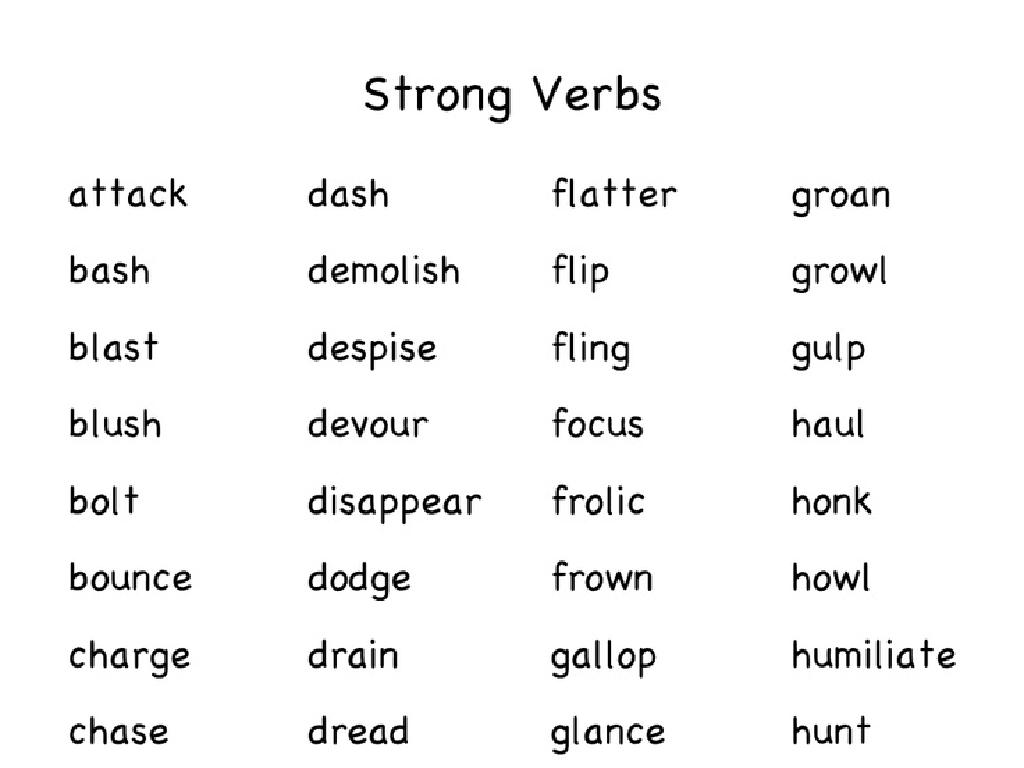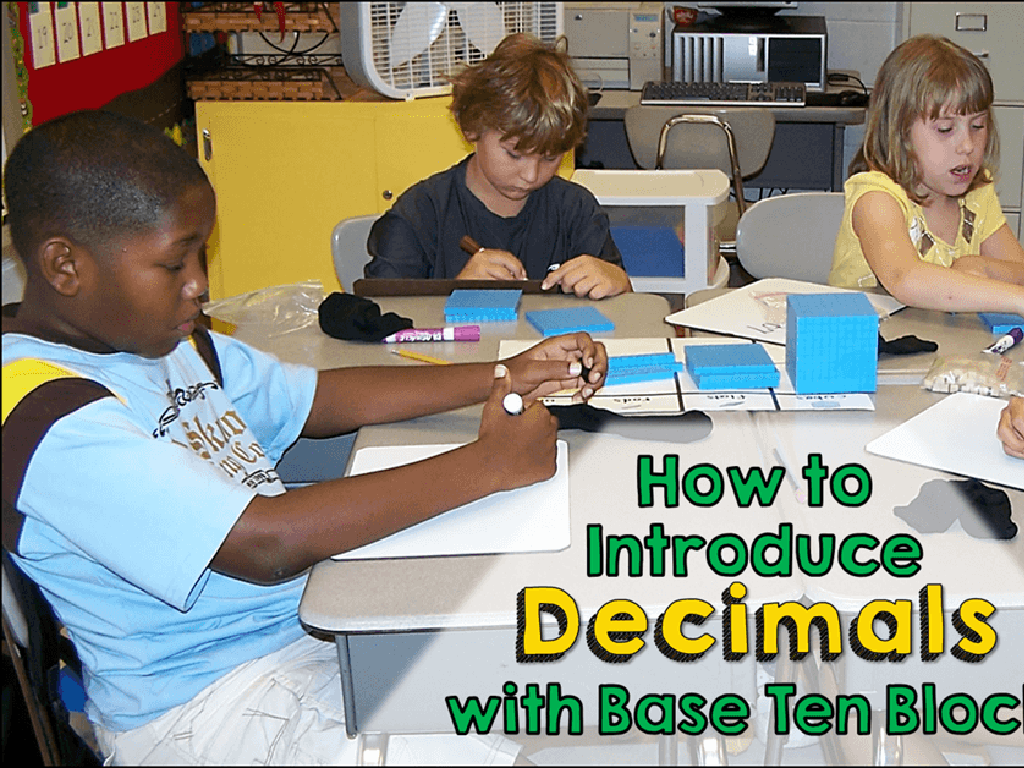Find The Distance Between Two Points
Subject: Math
Grade: Eighth grade
Topic: Coordinate Plane
Please LOG IN to download the presentation. Access is available to registered users only.
View More Content
Finding Distance on the Coordinate Plane
– Understanding the Coordinate Plane
– A 2D space with horizontal (x-axis) and vertical (y-axis) lines
– Defining a Point on the Plane
– A location defined by an ordered pair (x, y)
– Calculating Distance Between Points
– Use the Pythagorean theorem to find distance
– Applying the Distance Formula
– Distance formula: ((x2 – x1)² + (y2 – y1)²)
|
Begin with a review of the coordinate plane, ensuring students can identify the x-axis and y-axis and understand their significance. Introduce the concept of a point on the plane as an ordered pair of numbers. Focus the lesson on how to find the distance between two points by drawing a right triangle and using the Pythagorean theorem, leading to the distance formula. Provide examples with coordinates for students to practice, and encourage them to visualize the process as finding the hypotenuse of a right triangle formed by the two points.
Exploring the Coordinate Plane
– Define the coordinate plane
– A two-dimensional surface for graphing equations or points
– Understand the X and Y axes
– X-axis is horizontal, Y-axis is vertical
– Learn about the four quadrants
– Quadrants I, II, III, IV defined by the axes
– Plotting points (x, y)
– Each point is defined by an (x, y) pair
|
Begin with the definition of the coordinate plane, emphasizing its importance as a foundational concept in graphing. Explain the X-axis and Y-axis as the two perpendicular lines that divide the plane into four quadrants. Illustrate how every point on the plane is determined by an (x, y) coordinate, where ‘x’ represents the horizontal position, and ‘y’ represents the vertical position. Use examples to show how points are plotted and how the quadrants are labeled counterclockwise starting from the upper right quadrant. This will set the stage for understanding how to find the distance between two points in subsequent lessons.
Plotting Points on the Coordinate Plane
– How to plot points with coordinates
– Each point has an x (horizontal) and y (vertical) coordinate
– Practice example: Plot (3, 4) and (-2, -1)
– Start at the origin (0,0), move 3 right and 4 up for (3, 4); move 2 left and 1 down for (-2, -1)
– Class activity: Plot your own points
– Use your grid to plot points provided by the teacher
|
Begin with explaining the coordinate system, emphasizing the x (horizontal) and y (vertical) axes. Use the practice example to visually demonstrate plotting points (3, 4) and (-2, -1) on the board. For the class activity, distribute grid paper and have students plot a series of points you provide. This hands-on activity will help solidify their understanding of coordinates. Offer guidance as needed and encourage students to check each other’s work for accuracy. Possible variations for the activity could include plotting points to form a shape or finding the distance between plotted points to integrate the next lesson on finding distances.
Exploring Distance on the Coordinate Plane
– Define mathematical distance
– The length between two points measured along the shortest path connecting them.
– Distance in daily life
– Driving from home to school, or the flight path between two cities.
– Distance’s role in different fields
– Used in navigation, architecture, and sports analytics.
– How to calculate distance
– Use the distance formula derived from the Pythagorean theorem.
|
This slide introduces the concept of distance within the context of mathematics and its application to the coordinate plane. Begin by defining distance as the measure of space between two points, which can be visualized as the straight line connecting them. Provide relatable examples such as the distance one travels from home to school or between cities. Highlight the importance of calculating distance in various professional fields such as navigation for pilots, design in architecture, and strategy in sports. Conclude by explaining that the distance on a coordinate plane can be calculated using the distance formula, which is an application of the Pythagorean theorem. Encourage students to think of other areas where distance plays a crucial role and to be prepared to learn how to compute it mathematically in the following slides.
The Distance Formula on the Coordinate Plane
– Derive Distance Formula from Pythagorean Theorem
– Use right triangles to link Pythagorean Theorem to the coordinate plane
– Distance Formula: d = [(x2 – x1)² + (y2 – y1)²]
– x1, x2 are x-coordinates; y1, y2 are y-coordinates of two points
– Understand each component of the formula
– ‘d’ represents distance, ‘ ‘ is square root, and ‘²’ is squaring numbers
– Practice with example coordinates
– Example: Find distance between (3, 4) and (6, 8)
|
This slide introduces the Distance Formula as a method to calculate the distance between two points on a coordinate plane. Begin by explaining how the Distance Formula is derived from the Pythagorean Theorem, which students have learned in relation to right triangles. Emphasize that each component of the formula corresponds to the difference in x-coordinates and y-coordinates of the two points. Clarify the meaning of each symbol in the formula. Conclude with a practical example, calculating the distance between two specific points, to solidify their understanding. Encourage students to practice with additional points to become comfortable with the formula.
Applying the Distance Formula
– Understanding the Distance Formula
– Step-by-Step Example
– Use the formula d = ((x2 – x1)² + (y2 – y1)²) step by step
– Practice Problem: (2, 3) to (5, 7)
– Calculate the distance between points (2, 3) and (5, 7)
– Pair Work on Problems
– Work with a partner to solve similar problems
|
This slide introduces the Distance Formula as a method to find the distance between two points on a coordinate plane. Begin by explaining the formula d = ((x2 – x1)² + (y2 – y1)²), where (x1, y1) and (x2, y2) are the coordinates of the two points. Walk through a step-by-step example using the Distance Formula, ensuring to clarify each step. Present a practice problem for the class to solve, using the points (2, 3) and (5, 7). Finally, organize a class activity where students pair up and work on practice problems, applying the Distance Formula to find distances between various pairs of points. Provide guidance and support as students work through the problems. This activity will help solidify their understanding of the concept through collaboration and practice.
Troubleshooting Common Mistakes
– Avoid calculation errors
– Double-check each step, especially signs
– Check work for accuracy
– Review your solution; compare with examples
– Tips to remember the formula
– Use mnemonic devices or relate to known shapes
– Practice problems
– Solve diverse problems to reinforce the concept
|
This slide is aimed at helping students minimize errors when finding the distance between two points on a coordinate plane. Emphasize the importance of careful calculation, paying special attention to the signs of the coordinates, as mixing these up can lead to incorrect results. Encourage students to always check their work by reviewing each step and comparing their answers with similar problems they know are correct. Provide tips for remembering the distance formula, such as creating a catchy mnemonic or visualizing the formula as the hypotenuse of a right triangle. Lastly, give students a variety of practice problems to apply the formula in different contexts, which will help solidify their understanding and recall of the process.
Class Activity: Distance Challenge
– Group activity on point distances
– Apply knowledge to real-world
– Use a map to find distances between landmarks
– Share and discuss solutions
– Each group explains their strategy
– Reflect on different methods
– Discuss how various approaches can lead to the same result
|
This interactive group activity is designed to help students apply their understanding of finding distances between points on a coordinate plane to a real-world context. Divide the class into small groups and provide each with a map featuring various landmarks. Students will use the distance formula to calculate the distances between these points. After the activity, groups will share their solutions and discuss the methods they used. This will allow students to see different problem-solving strategies and understand that there can be multiple ways to approach a mathematical problem. Possible activities: 1) Calculating the shortest route between cities, 2) Finding the distance between planets on a scaled solar system map, 3) Measuring distances between points in a treasure hunt, 4) Comparing distances between home and school for each student, 5) Creating a map of the classroom and measuring distances between furniture.
Conclusion: Distance Between Points
– Recap key lesson points
– Open floor for Q&A session
– Homework: Practice worksheet
– Complete worksheet on finding distances
– Reinforce learning at home
– Practice solidifies the concept
|
This slide wraps up the lesson on finding the distance between two points on the coordinate plane. Begin by summarizing the main points, such as the distance formula, how to plot points, and how to calculate the distance. Open the floor for a question and answer session to address any uncertainties students may have. Assign a practice worksheet as homework to reinforce today’s learning. Encourage students to attempt the worksheet independently, reminding them that practice is crucial for mastering the concept. The worksheet should cover a variety of problems to ensure students are well-prepared to apply the distance formula in different contexts.






